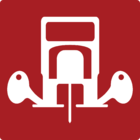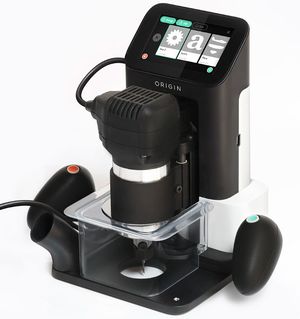Handheld CNC Router
Make: Shaper
Model: S01-NN Origin
Serial Number: 40083933
Ace: Needed (Makerhub@georgefox.edu).
Location: Wood Shop
Safety First
- Remove any adjusting key or wrench before turning the power tool on. A wrench or a key left attached to a rotating part of the power tool may result in personal injury or damage the machine.
- Always use the dust collection system to keep the dust levels in the wood shop from reaching a dangerous level.
- Always hold onto the router while it is cutting. It is a CNC but it is not fastened to anything and could tip over if the bit catches on the material.
- Cut at an appropriate feed rate. If Origin’s correction range is unable to keep up with your feed rate, move Origin slower, reduce the depth of cut, change your router bit, and/or adjust the spindle speed.
- Adhere work piece elements that may come loose during cutting. When cutting items out of work piece materials, use double sided tape or alternative methods to hold elements down to your workbench and/or spoil board. This will prevent items from coming loose when cutting is complete.
Description
The handheld CNC is a relatively small and portable computer automated router that can be moved around a flat, wooden surface. It uses location tracking and a moving spindle to provide an easy way to make precise cuts using a handheld machine which makes it great for performing high precision or detailed cuts. A camera is used to track its location by referencing a special tape which you apply to the surface you want to cut on. The spindle and router bit for the CNC are small, so the CNC is best suited for shallow cuts and engraving work. Despite the shallow cuts, the CNC is still capable of cutting non-shallow material thicknesses, it just means that multiple passes will have to be made.
Documentation
Terminology
- SVG - SVG is the file type for the graphics file that the CNC uses for its cuts. SVG stands for “Scalable Vector Graphics” and can be opened/modified with Adobe Illustrator, GIMP, and some others.
- Pocket Cut - The cut setting for hallowing out the center of a shape.
- Shaper Tape - A custom tape with special graphics on it that is used by the router to orient itself in space.
- Spindle - The part of the router that spins.
- Collet - The clamp that secures the router bits.
Handheld CNC Router User Manual
Training
Operation
Before a cut can be performed with the handheld CNC router you must provide a cut design in the form of an SVG file. These can be created in several different programs but Inkscape is recommended because it is installed on the hub computers and is free to download onto a personal device. When designing your cut use the actual dimensions of the cut. If it is your first time using Inkscape there are tutorials on their website and Youtube as well. Alternatively, you can download SVG from a website like this. After you have created the cut file transfer it to the router using a USB drive or by uploading it over WiFi.
Take the CNC out of the box, set it on a flat, wooden surface, and plug it in. Ensure that the dust collection vacuum is working and has a good seal on the CNC connecting piece. You should never use the CNC without dust collection working! Determine the area on the wood material that you want to cut on and place several strips of tape a bit beyond the width and height of the area you’ll need, with 4-6 inch separation between the tape strips (they don’t need to be straight and parallel, they can be crooked). The CNC uses this tape to manage the CNC’s position. Double check that the correct router bit is secure and in place in the spindle. If the router bit needs to be replaced or secured, make sure that the spindle is turned off and unplugged from the main computer of the router before you take the spindle out of its place. Keep in mind that the switch for the spindle only turns off the spindle, not the CNC computer system.
On the touch interface, select the scan mode and create a new scan for the tape. Move the CNC around the surface until all of the (unripped) tape is highlighted blue. It is important to have enough tape, if the CNC loses track of enough tape it will immediately raise the spindle and stop the router from cutting any material. Once you’re ready, go to the cut menu on the CNC’s touch interface and select the correct diameter for your router bit and the depth your want to cut. It will ask you to “touch off”, select yes. Touching off means that the CNC will lower the router until it just touches the surface in order to calibrate the depth control for the router. Select the appropriate cut type (inside, outside, on-line, or pocket) for the cut you will be making. The pocket cut type will cut out the entire area of the shape you have selected. The guide cut type will not act as a cutting line, it will only show on the display as a reference. You can preview the cut size and direction by looking at the direction of the dashed outline and the thicker, grey line on top of the small, dashed line. Double check that the spindle speed (the control wheel to the right of the spindle) is set correctly. Before you make your first cut, double check the tape accuracy by moving the CNC around and watching the tape icon on the top-right of the display. This shows how much tape is visible to the camera, so the more full the tape bar is the better. If it is consistently low, it may be best to add more tape and do a new scan. Once these things have been completed, you should be good to go for cutting! Keep in mind that you may have to do multiple passes to get the right depth and you may also have to change cut type depending on what kind of cut you’re trying to make.
Demonstration
For the demonstration, download this file as an SVG and open it in Inkscape. Download the SVG template from Shaper's website and copy that into the previously downloaded image. Use the eyedropper tool and paint can tool to replace the black outline of the bear with the grey color found on the template. Add a black box around the bear to act as an edge to cut through. Make sure that there is enough distance from the box to the bear, as the black line indicates an inside cut (so the router bit will be cutting on the inside of the box). Once finished, delete the template and save the file as an SVG to an SD card. Complete the demonstration by setting up the router and cutting the file.
General Procedure
Included in this section are some helpful videos made by Shaper that walk through the entire process of using the router. It is highly recommended that you look through the videos but if you do not then there are instructions walking through the same process.
Setting up the Cut Area:
- Remove the router from its box.
- Power on the router buy plugging in the device. Do not flip the switch attached to the spindle motor to the on position.
- Place at least three strips of Shaper Tape slightly above the area you want to cut so that the router will be able to orient itself. They do not have to be straight line but do need to be in the same plane.
- Select the new scan option on the router and move the router around the work area until all of the tape is highlighted in blue on the screen. This establishes a work plane that the router can reference during a cut. After you have scanned the tape it will take some time for the router to stitch together the work space in its software. Once it is completed, a screen will appear displaying a cross hare that represents the location of the router bit on the work space. You can also zoom out by double tapping the screen to see the complete work area.
- Select the design option on the right of the screen to move onto setting up the cut.
- Bring the file onto the router. The router is capable of receiving files WiFi using individual Shaper accounts but it is quicker and easier to use a Usb drive to transfer files. If using a Usb drive, plug it into the side of the router and then use the plus symbol on the left of the screen to navigate to your file. After selecting your file, the router should display the work space with the file overlaid on top of it.
- Move the cut file to your desired location and press place to establish where you want to cut on the work space. You can put it in a very precise place by zooming in and matching the edges the cut file and work piece together.
- Install your desired bit. Unscrew the bolt on the right of the spindle just loose enough to remove the spindle. To remove the router bit, press down on the locking mechanism and twist the collet until the router bit can be removed. Make sure that the router bit grooves are not below a quarter inch from the top of the collet. Once a new router bit has been put in place, use the wrench to tighten the collet. Reinsert the spindle into the slot on the CNC and tighten the bolt “finger tight”.
- Hook up the router to the dust collection system (aka the shop vac) using the included hose and the dust port on the router base.
- Press the cut option on the right of the screen and you are ready to cut.
- Make sure that you place a spoil board below the material you are cutting so that you do not cut the table. Also be sure to secure the work piece so that it will not shift while you are routing. There is not a specific way to do this but double sided tape may be helpful.
Performing a Cut:
- Select the air cut type in the upper left of the screen and move the router over top of your first cut line so that the line is highlighted as moving dashed line. This indicates the direction your cut should be made in. Make sure to select your bit size and cut location at this point. The cut location can be on the line, inside the line, or outside the line based on your application. There are other cut settings you can experiment with as well.
- Hit the green button to begin the cut. The cut is indicated by a blue line and the center if the bit is indicated by a white dot. The router can move the bit anywhere within the larger white circle so make sure to keep the cut line within the large circle and the router will take care of the rest. There is also an auto advance feature that will move the bit forward to the edge of the large circle.
- Run through your air cut until you get a feel for how the router responds and are confident the cut file is correct.
- Change from an air cut to a whatever cut depth you desire. A good rule of thumb is to never cut deeper than 1.5 times the diameter of the cutting tool.
- Make sure the spindle motor is plugged in and the correct bit is selected.
- Press the z touch button on the left of the screen to zero the router bit to the surface of the work piece.
- Set the spindle speed. The spindle speed can also be adjusted using the dial on the side of the spindle motor if needed.
- Hit the green button on the handle or press start on the screen to perform the cut.
- Reset the space when finished by vacuuming any dust, returning the router to its box, and putting away any scrap material.
Certification
Complete the Wood Shop - Handheld CNC Router Module at the link below to gain access to the Handheld CNC Router. The Maker Hub Canvas course pertains to all facilities and equipment contained in the Maker Hub; simply complete the quizzes for the facilities/equipment you wish to use in the Maker Hub. Please email makerhub@georgefox.edu if you have any questions.
Troubleshooting
- Cut is to big or small. The router will cut exactly on the cut line which often results in tight fitting parts. Use the offset option in the cut settings to increase or decrease the cut size by a minimal amount.
- The router keeps losing track of the Shaper Tape during a cut. Try rotating the router during the cut so the camera is always pointing towards the tape. If the problem persists add more tape.
Maintenance
General maintenance
To keep this machine working properly, wipe off any dust that was collected on it while cutting before putting it away. There is also a chip tray on the front of the router that needs to be cleaned out as it fill up.
Specific Maintenance Tasks
| Maintenance Procedure | Frequency | Done By | |
|---|---|---|---|
| 1 | Wipe down the Router | After each use | Student |
| 2 | Clean the chip tray | When it is close to full | Student |


